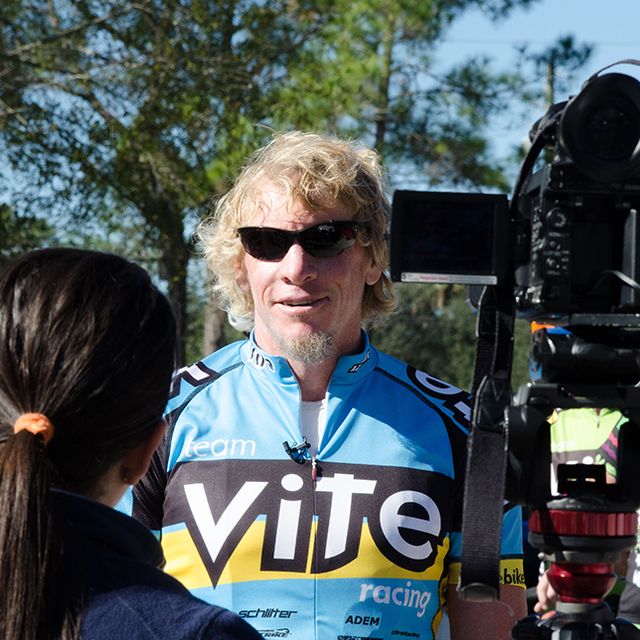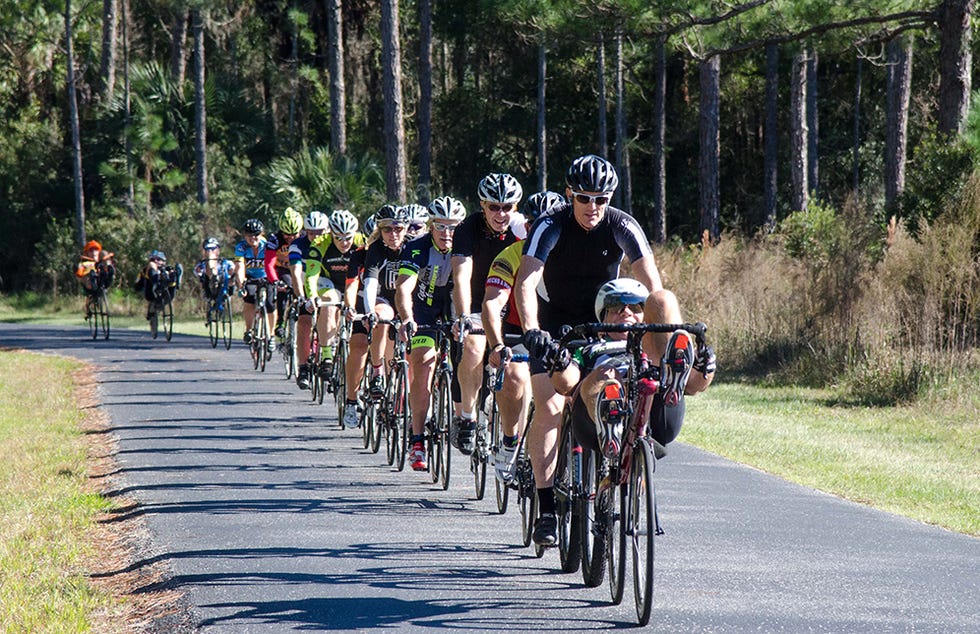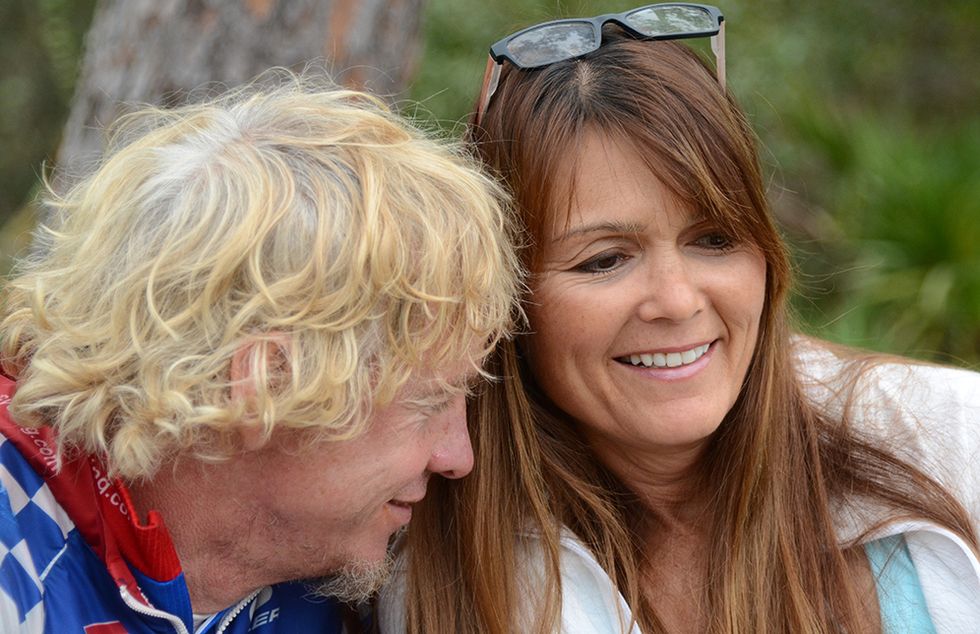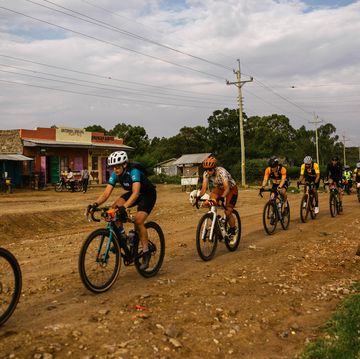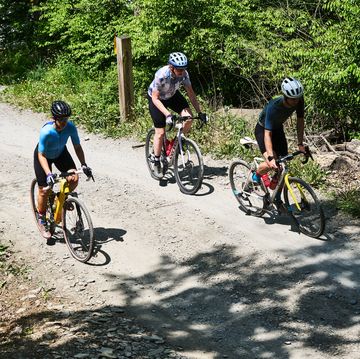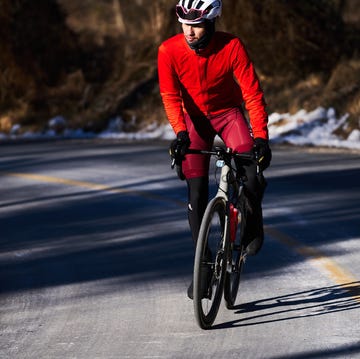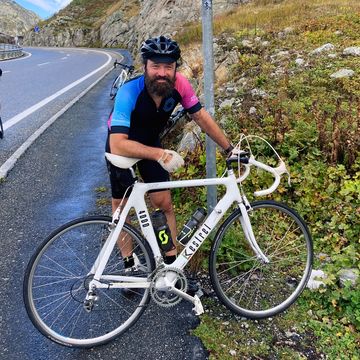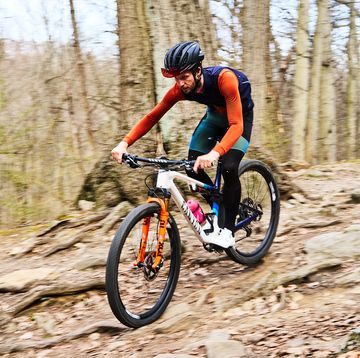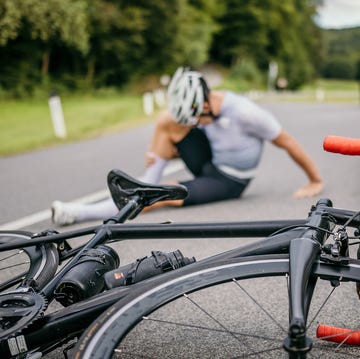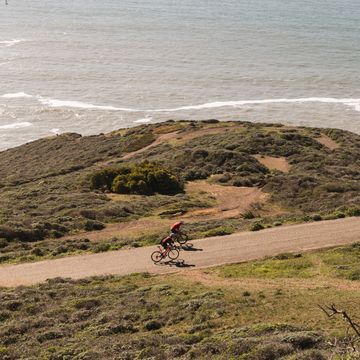Two days before he would break the record for the most miles cycled in a single year, “Tarzan” Kurt Searvogel rode in the darkness around a circuitous seven-mile trail in Flatwoods Park, on the outskirts of Tampa, Florida. The wide beam of his bike light illuminated a tunnel of tall pines. Over a swampy creek, a hawk swooped across his path. A deer watched through the forest. Wild boars prowled the brush.
It had been a good day for Tarzan, and his energy was palpable. With the aid of a half dozen volunteer pacers, he had averaged over 20 mph for the past 12-plus hours, and on this evening he would accrue 240 miles total. He had ridden 221 miles the day before. And 226 miles the day before that. And so on.
RELATED: 40 Reasons to Ride More in 2016
After 11 months and three weeks of near-consecutive 200-plus mile days of cycling, he sat at the cusp of breaking a 75-year-old cycling mark, the highest annual mileage record (or, HAM’R). About 320 miles of the 75,065 total miles he needed to become the new HAM’R champion remained.
For Tarzan, that meant roughly a day and a half more of riding.
The sky was clear and the air warm, and Searvogel, known for his stoic demeanor aboard his bicycle, felt not anxious or highly fatigued with the record so close at hand, but oddly at peace. “Why am I doing this?” Searvogel said aloud without prompting. “Because it’s there, maybe? Because they said it couldn’t be done.”
He had always felt he could break the record. He called it a math equation: How long would he need to ride, how fast would he need to go, and still have enough time to eat and sleep? Searvogel, a software engineer, always liked math.
But as he neared the record, he found a higher, and perhaps more important purpose in his year-long quest. He found that he inspired people. “I have a gift, I guess,” he said, still seeming a bit uncomfortable in his newfound role. “I can ride my bike really far, and really fast. This has been my way of sharing that gift.”
RELATED: How These Amateur Cyclists Ride 10,000 Miles in a Year
At the behest of his wife and sole support person, Alicia Searvogel, he decided to base himself out of Flatwoods Park for the final six weeks of his record attempt. The park’s wide, smooth, and flat trails provided an ideal surface. The tall pines shielded him from riding in the headwind he despises so much. He need not risk a crash with a vehicle on the open roads. An array of chain restaurants, providing the calorie-dense food Searvogel required as fuel, sat just a crosswalk away from Flatwoods.
And here, too, people could find Tarzan more easily—and so they did. They came from across the state of Florida and around the country to ride with him, to offer him a draft, to break the monotony—to be his friend.
Rubin Randel, a lean 60-year-old aboard a recumbent bicycle, drove his RV up from Sarasota. Randel’s wife had recently passed away after extended illness. “I’ve been a caregiver for over a decade,” he said. He’d only recently begun riding again, in earnest. “What Kurt’s doing, it’s like we’re witnessing the Babe Ruth of bicycling.”
Wes Wilmer, 59, from Virginia, was struck from behind by a hit-and-run driver in 2014. The driver, who was eventually found, had been arrested a year earlier for reckless driving in a crash that killed two children, but the judge declined to press charges. Wilmer still uses crutches to walk, but he’s regained a modicum of his former racer strength. He came to Flatwoods, too, to help Kurt reach the record.
RELATED: We Dare You to Start a Ride Streak
Amanda Coker, 23, from North Carolina, was one of the country’s best young racers, on scholarship at Fort Lewis College, when she and her family suffered a litany of misfortune—a rare heart condition that required surgery, a subsequent crash, and medical bills that piled up. Her family lost their house, and moved to Tampa seeking a fresh start. She found Searvogel at Flatwoods, and this December, rode more miles on Strava than any other woman in the world.
In these final weeks before reaching the record for the most miles ridden in a single year, Searvogel often found himself surrounded by a dozen or more cyclists and supporters. They ride 50, 100, or sometimes even 200 miles in a single-file paceline, zipping along at 22 mph, Searvogel’s chosen pace. Each had his own reason for being there. Each found her own inspiration in this once-solitary journey. And each, in turn, has helped inspire Searvogel.
Only a few months prior, Kurt and Alicia assumed that, should they manage to reach the record, they would crawl across the line. But here, now, on the cusp of 75,065-miles, they found themselves sprinting toward the finish.
The annual mileage challenge was first put forth and monitored by the British magazine Cycling in 1911. Contestants sent in detailed training logs, verified by witness signatures, and into the 1930s the record inched ever upward. Then, in 1939, a vegetarian delivery boy named Tommy Godwin bested the previous record by nearly 10,000 miles. Godwin, aboard a steel Raleigh Record Ace, set a mark of 75,065 miles (an average of 205 miles per day, or three times the circumference of the planet), and effectively nullified any subsequent record attempts.
At the time, Godwin was hailed as a national hero, his exploits highly touted. But in the 75 years that passed, his record had been largely forgotten by all but a handful of hardened endurance cyclists. In 2015, after numerous requests to ratify modern-day annual mileage attempts, the Ultra Marathon Cycling Association decided it might benefit from the publicity of those seeking to break Godwin’s mark, and established a set of rules and a website to track competitors.
Searvogel knew little about Tommy Godwin, or even if Godwin had really ridden all those miles. But he’d been recently divorced, he’d met Alicia, and the two of them were seeking an adventurous challenge. Searvogel built a year-long plan into a massive spreadsheet, acquired the requisite GPS trackers, and then, on January 10, 2015, began riding.
He started in Florida, at a pace so rapid many assumed he might burn out quickly, often averaging over 20 mph for more than 12 hours at a time. But he remained, mostly, consistent. In the spring, he rode back toward his home outside of Little Rock, Arkansas, where he weathered torrential storms, and then migrated northward to Wisconsin, where he was born, during the summer.
Initially, Searvogel thought he would gain fitness and speed over the course of the year. But in Wisconsin, he quickly realized the foolishness of that prediction. He sometimes found himself struggling to maintain a pace of just 16 mph. At times, Alicia joined him, and inadvertently left him behind.
The stress of the record, and the thousands of miles that remained, had begun to wear on them both. Their roving lifestyle (an attempt to ride as much tailwind as possible) left Alicia constantly searching for places to get food, do laundry, and repair bicycles. They began to feel isolated, and increasingly tormented by the odd assortment of haters who continued to hound them online.
RELATED: Why This Cyclist Climbed 95,000 Feet in Two Days
Searvogel had begun his record attempt only days after British ultra cyclist Steve Abraham began working toward the same goal. And while Searvogel admittedly tried to make every mile as easy as possible, Abraham hued more closely to the nostalgia of Godwin, riding entirely within the UK and piloting a steel Raleigh bicycle. An intense rivalry developed between the two riders, and even after Abraham was struck by a moped and forced to restart his record attempt, a handful of Abraham supporters began hounding Searvogel on social media, calling him unworthy of Godwin’s mark.
While Kurt tried to remain focused on riding, Alicia bore the brunt of the stress. Her teeth cracked from nighttime grinding, and her hair began to fall out. They headed back toward Arkansas, not knowing whether they would reach the record. One day, Alicia woke to find Kurt curled up on the couch, napping instead of riding. “Is this where we fell off the cliff?” he'd asked her.
In Arkansas, Alicia had called on the local cycling community for help, to come ride with Kurt, to break the monotony, to help them regain their momentum toward the record. She healed from the stress, and then they went to the County Courthouse and got married. (Kurt only logged 175 miles that day.)
On the morning of Monday, January 4, at 6:13 a.m., Kurt Searvogel left the parking lot of a La Quinta hotel directly adjacent to Flatwoods Park, where he and Alicia had been living for the past month and a half, and began his record-breaking ride. The previous day, in cold and wet conditions, he’d logged 188 miles. Only 140 more miles remained to match, and then surpass, Godwin’s number.
Now, at Flatwoods, the pair had sought and found the same kind of community as in Arkansas. As the record day progressed, more and more riders entered the park, until eventually a peloton of supporters enveloped Searvogel. At 2:30 p.m., Searvogel stood only five miles from Godwin’s record. He and Alicia rode alone, two and a half miles down the trail, and their friends unfurled a banner behind them—“76,065 miles and counting.” His record attempt would officially end on Saturday. A local news crew attached a camera to a bicycle’s handlebar, and a pair of Tampa Tribune reporters (aboard vintage road bikes) recorded the action.
RELATED: How to Train for Your First Century Ride
The couple returned. Rode through the banner. Kissed. “Let’s go ride!” Searvogel said, and everyone followed him back down the trail. Searvogel led the pack, riding much faster than his normal, controlled pace, happily wasting energy.
Later, when he returned to the park entrance to refuel (he’d hoped to reach 200 miles that day, he said, “so no one could give him shit”), he was greeted by his three kids—two daughters and one son, all of them young adults.
They’d driven 14 hours from Arkansas to be with him; to show him that they, too, supported him. They each gave him a big hug, and later that evening, they all sat together at a nearby bar, where the riders of Flatwoods had staged a party to celebrate Searvogel's achievement. His kids said that even though they hadn’t really seen him in an entire year, they understood why he did what he did. They said their dad was so, so driven, and that they’d been impressed with Alicia’s ability to channel his athletic ambition. His kids were not endurance cyclists—and perhaps couldn’t relate to his accomplishment in the same way that someone who really loves bikes might—but they said that no one could deny this, that on this day, their dad had become a legend.
Ian Dille is a freelance writer and producer based in Austin, Texas. He tells stories about bikes, and other things, too.
